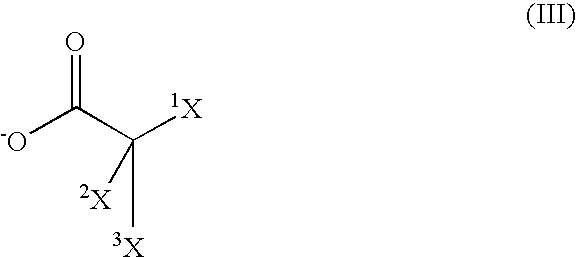Low viscosity allophanates containing actinically curable groups
a technology of allophanates and actinically curable groups, which is applied in the direction of polyurea/polyurethane coatings, organic chemistry, coatings, etc., can solve the problems of high reaction temperature requirements for this purpose (130° c. ), and achieve the effect of low residual monomer conten
- Summary
- Abstract
- Description
- Claims
- Application Information
AI Technical Summary
Benefits of technology
Problems solved by technology
Method used
Image
Examples
example 1
Choline ethylhexanoate
[0123] 272.13 g of a 40% solution of choline hydroxide and 145.73 g of 2-ethylhexanoic acid were stirred vigorously for 30 min at RT in a glass flask with reflux condenser, heatable oil bath, mechanical stirrer and internal thermometer. Water and methanol were distilled off in a rotary evaporator at 30-45° C. under a vacuum increased gradually to 20 mbar. The product was then taken up in n-hexane and re-evaporated in the rotary evaporator and dried at 0.1 mbar and 40° C. for 2 h, giving a slightly colored, viscous liquid whose 1H-NMR spectrum showed equimolar ratios of choline and ethylhexanoate, but only a weak signal in the region of aliphatic carboxylic acids.
example 2
Allophanate-containing Binder According to the Invention
[0124] 263.47 g of Desmodur® N3400, 0.50 g of 2,6-di-tert-butyl-4-methylphenol and 0.07 g of Desmorapid® Z were introduced at RT into a three-necked flask with reflux condenser, stirrer, dropping funnel and air stream (0.5 l / h) and then heated to 60° C. 219.54 g of 2-hydroxyethyl acrylate were slowly added dropwise, during which a maximum temperature of 70° C. was reached. The reaction mixture was then held at 65° C. until the NCO content was −1. 0.50 g of isophthaloyl dichloride were added, and the mixture was rapidly cooled to RT. Gas chromatography of a sample showed a hydroxyethyl acrylate content of 4.68%. 39.0 g of Desmodur N3400 and 0.07 g of Desmorapid® Z were added. The mixture was stirred at 60° C. until a signal for the isocyanate group was no longer present in the IR spectrum at ν=2272 cm−1. Gas chromatography of a sample showed a hydroxyethyl acrylate content of 0.18%. A product having a viscosity of 64,500 mPas / 2...
example 5
Coating Formulation and Coating Material
[0131] A portion of the product from Example 2 was mixed thoroughly with 3.0% of the photoinitiator Darocur® 1173. Using a bone hand coater with a gap of 90 μm the mixture was drawn down in the form of a thin film onto a glass plate. UV irradiation (medium pressure mercury lamp, IST Metz GmbH, Nürtingen, DE, 750 mJ / cm2) gave a hard, transparent coating which was solvent-resistent, had a pendulum hardness of 152 s, could hardly be damaged by scratching using steel wool (grade 0 / 0 / 0) in ten back-and-forth strokes with a force of 500 g directed onto the film and was not visibly altered after 100 back-and-forth strokes with a wad of cotton wool soaked in butyl acetate.
PUM
| Property | Measurement | Unit |
|---|---|---|
| Temperature | aaaaa | aaaaa |
| Temperature | aaaaa | aaaaa |
| Aliphatic | aaaaa | aaaaa |
Abstract
Description
Claims
Application Information
 Login to View More
Login to View More - Generate Ideas
- Intellectual Property
- Life Sciences
- Materials
- Tech Scout
- Unparalleled Data Quality
- Higher Quality Content
- 60% Fewer Hallucinations
Browse by: Latest US Patents, China's latest patents, Technical Efficacy Thesaurus, Application Domain, Technology Topic, Popular Technical Reports.
© 2025 PatSnap. All rights reserved.Legal|Privacy policy|Modern Slavery Act Transparency Statement|Sitemap|About US| Contact US: help@patsnap.com



